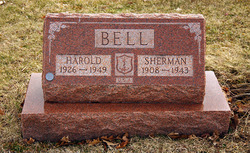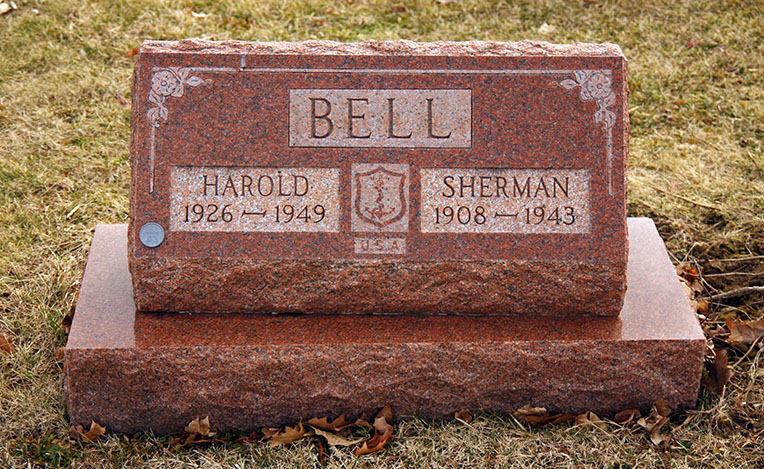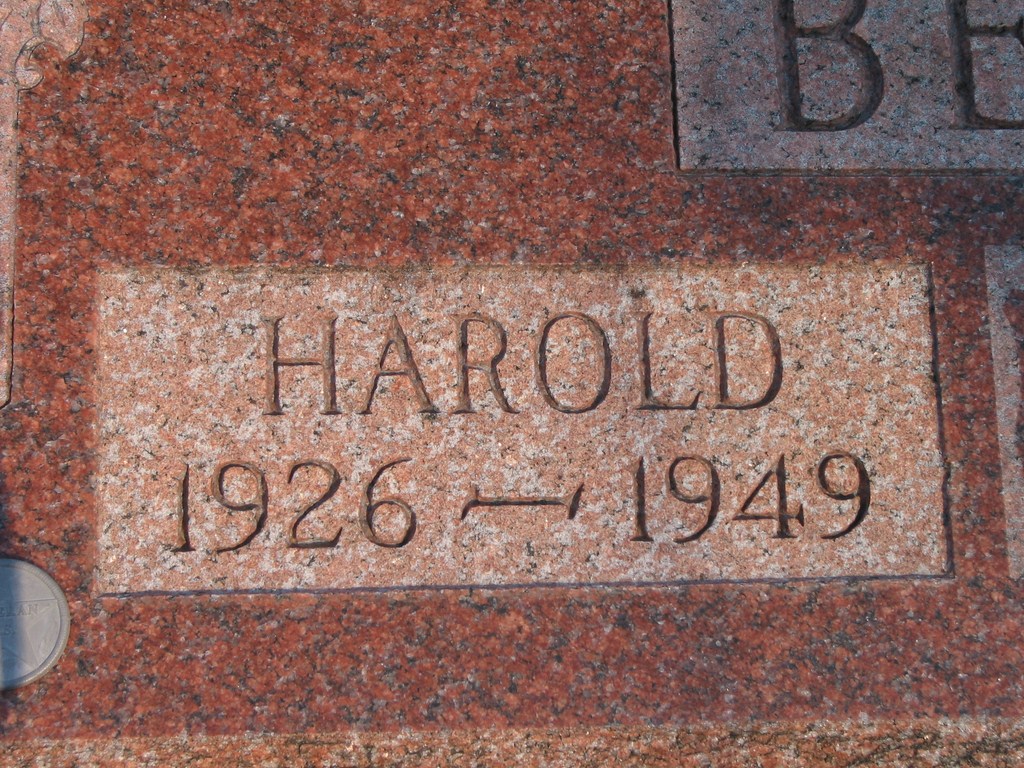Member of a family of twelve children, Bell was the second son of Mr. and Mrs. William Bell, 420 Hopewell Street, to lose his life in an accident. He was a brother of Sherman Bell, who died six years ago as a result of a fall in Chicago. He was serving in the U.S. Navy at the time and was based at Great Lakes Naval Training Station.
Today the local courthouse flag was lowered to half mast in honor of Harold Bell, whose body was removed the afternoon of March 19 from the coupe which had been his tomb for, it is believed, nearly 24 hours.
The coroner and sheriff conducted investigations during the weekend which brought to light the main details of how Harold Bell died but there are other details of the tragedy which will never be known.
Officials know, for example, that: Harold Bell had been missing since March 17, that the death car, standing upright on the bottom of Griffey Lake, was found March 19 some three feet below the surface with tire tracks leading into the water, and that Bell's body was inside the coupe when it was towed out of the lake by a wrecker truck. No evidence other than that of accidental death was uncovered by the investigation.
The body of young Bell was found in the car; huddled on the floor on the side of the coupe opposite the steering wheel.
Bell was an expert swimmer. He had even been a swimming instructor in the army. He must have died quickly, though, for he was still fully clad, having not even removed his shoes.
It was surmised that Bell may have been stunned when the car shot off the road; crashed over a steep bank with the bottom of the car scraping the edge as it went over. Bell, however, did not appear to have sustained any major injury from the crash and the car was scarcely damaged at all except for water damage. One window of the car was broken but this appeared to have been an old break. Through the broken window and a hole in the car floor the water doubtlessly rushed in swiftly.
Police Sergeant John Hacker said he was convinced that a defect in the steering gear of the coupe caused the accident. The left front wheel of the car was locked when the car came out of the water. Locking of the left front wheel would have caused the coupe to leave the road as it did, some 15 feet after crossing the bridge and hurtle into the lake.
A blinding snowstorm was raging at the time, a storm which even then was forcing two army fliers to abandon their plane in midair over a Lawrence County woods.
Bell who attended Bloomington schools, was inducted into the army on November 1, 1944 and received an honorable discharge on August 11, 1946. As a member of the thirteenth field artillery, Battery A, in World War Two, he served in the Pacific theatre and was stationed for a time in Japan. He came out of the army with the rank of private first class, and with a Victory Medal, Asiatic Theatre Ribbon, Good Conduct Medal, and two overseas service bars.
Employed since discharge as a construction worker, Bell was one of the men who installed Bloomington's new street lights. He operated an air drill on this project.
Surviving Harold Bell, in addition to his parents with whom he made his home are three sisters; Mrs. Myrtle Hacker, Mrs. Flora Crohn, and Mrs. Grace Hawkins; five brothers, Elmer, Michael, Phillip, and Moses Bell, and Staff Sergeant Ralph Bell.
In addition to Sherman Bell, three other brothers of Harold Bell died before him. They were James, Raymond, and Earl Bell.
-------------------------------------------
Taken from the Bloomington World-Telephone dated March 21, 1949.
Member of a family of twelve children, Bell was the second son of Mr. and Mrs. William Bell, 420 Hopewell Street, to lose his life in an accident. He was a brother of Sherman Bell, who died six years ago as a result of a fall in Chicago. He was serving in the U.S. Navy at the time and was based at Great Lakes Naval Training Station.
Today the local courthouse flag was lowered to half mast in honor of Harold Bell, whose body was removed the afternoon of March 19 from the coupe which had been his tomb for, it is believed, nearly 24 hours.
The coroner and sheriff conducted investigations during the weekend which brought to light the main details of how Harold Bell died but there are other details of the tragedy which will never be known.
Officials know, for example, that: Harold Bell had been missing since March 17, that the death car, standing upright on the bottom of Griffey Lake, was found March 19 some three feet below the surface with tire tracks leading into the water, and that Bell's body was inside the coupe when it was towed out of the lake by a wrecker truck. No evidence other than that of accidental death was uncovered by the investigation.
The body of young Bell was found in the car; huddled on the floor on the side of the coupe opposite the steering wheel.
Bell was an expert swimmer. He had even been a swimming instructor in the army. He must have died quickly, though, for he was still fully clad, having not even removed his shoes.
It was surmised that Bell may have been stunned when the car shot off the road; crashed over a steep bank with the bottom of the car scraping the edge as it went over. Bell, however, did not appear to have sustained any major injury from the crash and the car was scarcely damaged at all except for water damage. One window of the car was broken but this appeared to have been an old break. Through the broken window and a hole in the car floor the water doubtlessly rushed in swiftly.
Police Sergeant John Hacker said he was convinced that a defect in the steering gear of the coupe caused the accident. The left front wheel of the car was locked when the car came out of the water. Locking of the left front wheel would have caused the coupe to leave the road as it did, some 15 feet after crossing the bridge and hurtle into the lake.
A blinding snowstorm was raging at the time, a storm which even then was forcing two army fliers to abandon their plane in midair over a Lawrence County woods.
Bell who attended Bloomington schools, was inducted into the army on November 1, 1944 and received an honorable discharge on August 11, 1946. As a member of the thirteenth field artillery, Battery A, in World War Two, he served in the Pacific theatre and was stationed for a time in Japan. He came out of the army with the rank of private first class, and with a Victory Medal, Asiatic Theatre Ribbon, Good Conduct Medal, and two overseas service bars.
Employed since discharge as a construction worker, Bell was one of the men who installed Bloomington's new street lights. He operated an air drill on this project.
Surviving Harold Bell, in addition to his parents with whom he made his home are three sisters; Mrs. Myrtle Hacker, Mrs. Flora Crohn, and Mrs. Grace Hawkins; five brothers, Elmer, Michael, Phillip, and Moses Bell, and Staff Sergeant Ralph Bell.
In addition to Sherman Bell, three other brothers of Harold Bell died before him. They were James, Raymond, and Earl Bell.
-------------------------------------------
Taken from the Bloomington World-Telephone dated March 21, 1949.
Family Members
-
![]()
Sherman Bell
1908–1943
-
Earl Bell
1909–1909
-
![]()
Myrtle Evelyn Bell Hacker
1912–1969
-
![]()
Flora Alice Bell Crohn
1914–1996
-
![]()
Grace Eleanor Bell Hawkins
1915–1998
-
![]()
James William Bell
1917–1934
-
![]()
PFC Harley Elmer Bell
1919–1974
-
![]()
Michael E Bell
1921–1976
-
![]()
SFC Ralph Bell
1924–1951
-
![]()
Moses E Bell
1928–1988
-
![]()
Philip Lee "Babe" Bell Sr
1933–2015
Sponsored by Ancestry
Advertisement
Records on Ancestry
Advertisement


















